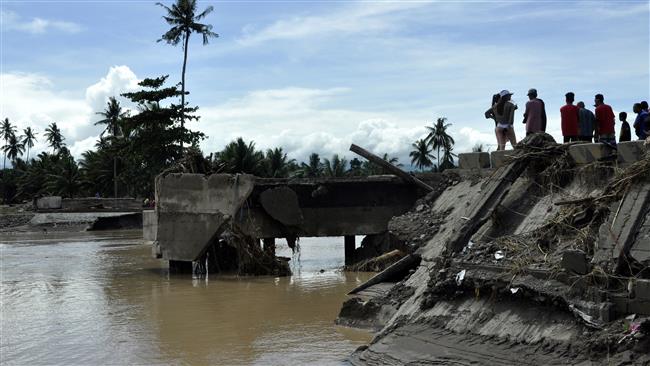56,000 Filipinos flee volcanic lava, ashes
The Philippines' most active volcano spewed fountains of red-hot lava and massive ash plumes anew Tuesday in a dazzling but increasingly dangerous eruption that has sent more than 56,000 villagers fleeing to evacuation centers.
Lava fountains gushed up 700 meters (2,300 feet) above Mount Mayon's crater and ash plumes rose up to 3 kilometers (1.9 miles) Monday night.
At least three major blasts followed Tuesday, including an explosion at nightfall that was capped by one of the most massive lava displays since the volcano started acting up more than a week ago, the Philippine Institute of Volcanology and Seismology said.
Authorities warned a violent eruption may occur in hours or days, characterized by more rumblings and pyroclastic flows — superheated gas and volcanic debris that race down the slopes at high speeds, vaporizing everything in their path.
After Monday's explosion, officials raised Mayon's alert level to four on a scale of five, and the danger zone was expanded to 8 kilometers (5 miles) from the crater, requiring thousands more residents to be evacuated, including at least 12,000 who returned to their homes last week as Mayon's rumblings temporarily eased and then scrambled back to the emergency shelters this week.

At least 56,217 people were taking shelter in 46 evacuation camps Tuesday and army troops and police were helping move more villagers from their homes, officials said.
Authorities struggled to prevent villagers from sneaking back to check on their homes and farms and to watch a popular cockfight in Albay's Santo Domingo town despite the risks and police patrols and checkpoints, said Cedric Daep, a provincial disaster response official.
In a sign of desperation, Daep told a news conference that he has recommended electricity and water supplies be cut in communities within the no-go zones to discourage residents from returning.
"If pyroclastic flows hit people, there is no chance for life," Daep said. "Let us not violate the natural law, avoid the prohibited zone, because if you violate, the punishment is the death penalty."
The daytime eruptions have plunged nearby villages into darkness and sent lava, rocks and debris cascading down Mayon's slopes toward the no-entry danger zone. There have been no reports of deaths or injuries.
(Source: AP)
VIDEO | Trump fighting allies on Greenland
Iran FM: Selective respect for deals now haunting Europe
Arab rights group urges UK to sanction Netanyahu over 'incitement to genocide' in Gaza
‘Political, non-constructive’: Iran slams UNHRC special session on recent riots
Forced evacuations in South Gaza as Israeli military expands control over land
Iran reports steep rise in exports after forex policy shift
Iranian bank loans up 47.2% y/y in Apr-Dec
Macron slams Trump’s ‘bullying’ as US threatens tariffs, pushes Greenland grab













 This makes it easy to access the Press TV website
This makes it easy to access the Press TV website